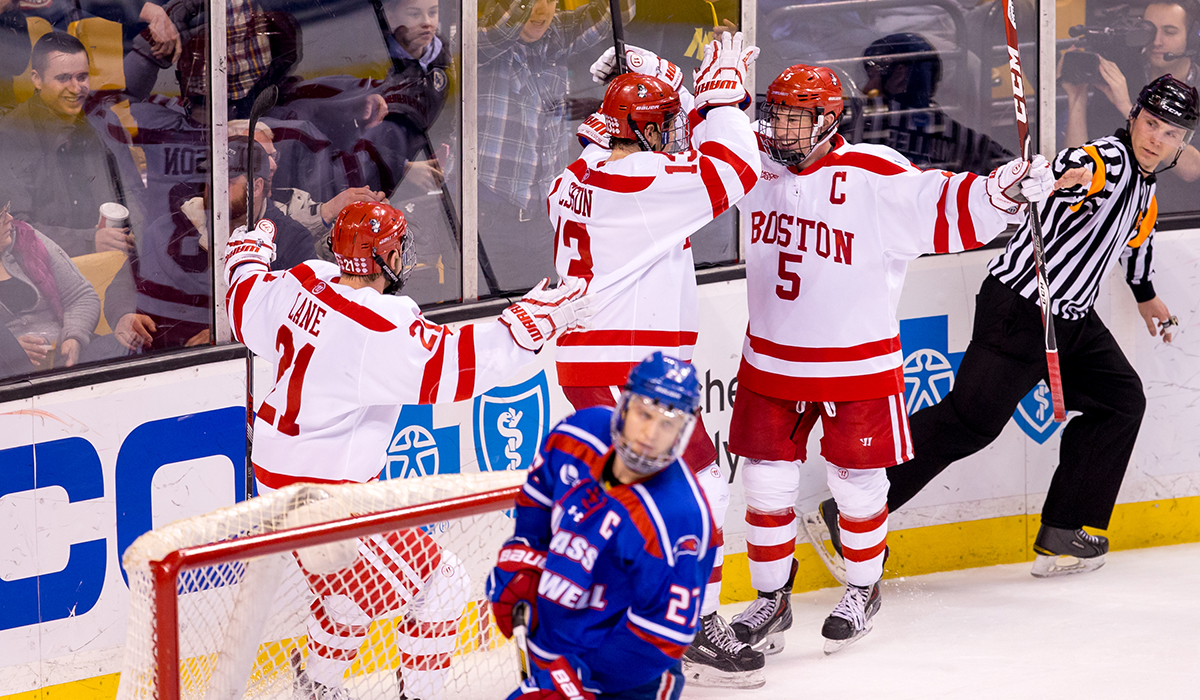Work Out Like: The Boston University Hockey Team

Boston University hockey photo provided
The No. 3 seeded Boston University (BU) Terriers are the only hometown team representing college hockey in this weekend’s Frozen Four at TD Garden. We spoke with Anthony Morando, strength and conditioning coach for the men’s ice hockey team, for a behind-the-scenes look at what happens off the ice. Below, how the team trains to be champions.
Emphasis on the entire body
With training sessions running all week, BU’s hockey players spend at least three hours a week strengthening their bodies in the weight room in addition to all of the time they spend practicing on the ice.
“Everything we do off the ice creates a readiness, a resilience and an alert component for those muscles that they need to use on the ice,” Morando says. “The players strengthen their hips, their core, their glutes, their quads, their hamstrings, their shoulders, their pecs. Their whole entire body is strengthened.”
Make it yours: It’s all about variety. So instead of going through the same workout every day, focus on different muscle groups each day of the week. This allows for a complete body workout over the course of the week, but ensures you won’t get bored and will stick to the plan. It also allows the muscles you aren’t using that day to recover and build up for your next workout.
Attention to detail
Training programs at BU are personalized for each player. So this way, every player gets a workout developed to optimize his own performance.
“As an S&C coach, what you need to do is really focus on which guy needs what in detail,” Morando says. “Whether it is working on compound movements or single leg movements, everybody is working out according to his own individualized workout.”
This ensures that forwards, defensemen, and goalies all get different, specialized workouts. For example, freshman phenom Jack Eichel has workouts specialized to stretch his hip flexors to accommodate the higher level of minutes he is seeing on the ice. On the other hand, defensemen will do things likes isometric squats to increase mobility while lowering their center of gravity. Matt O’Connor, the Terrier’s man-in-net, works on his quadrilateral muscles with exercises like bilateral squats.
Make it yours: Just like how each hockey player has an individual program, you need to develop a workout that fits your own body’s capabilities. For example, if you have had lower back injuries, hip injuries, or knee injuries, you should focus on strengthening the area around those joints before moving on to more strenuous exercises.
Conditioning is key
“Our game is a fast game. We are a very fast team,” Morando says. “And in order to stay fast and be fast, we need to be strong and we need to be well conditioned.”
Morando compares a hockey game to a 60 minute run. Players must be strong enough to run for the whole hour, but throughout the run there are shifts where the hockey players must “sprint” such as during a long shift or a power play. In these windows, players utilize many types of muscle energies at different times.
To build up the team’s stores of energy, he targets the body’s three energy processes: the phosphagen system (handles immediate energy); the glycolytic system (handles medium bouts of energy from the muscles); and the oxidative system (handles long lasting energy). By strengthening these processes through a mix of aerobic and anaerobic exercises, he can ensure that players are strong enough to play for the whole game.
Make it yours: Good conditioning is the key to staying fit. By utilizing cardiovascular exercises such as running, you can ensure that you have more energy for longer periods of time. This means longer workouts and less injuries.
Be Safe
In the offseason, players are encouraged to increase the intensity of their workouts to maximize gains in power and agility. However, during the season, workouts are tapered to encourage a safe and healthy environment and minimize injury.
“It’s the law of the farm,” Morando says. “If these guys increase in the offseason by five pounds a week, so be it. That’s the increase we want to have. But in-season, we level off and make sure the guys aren’t doing a large volume of training.”
Make it yours: Patience is key when developing a workout routine. Even if you don’t see results immediately, the magic is already happening in your body.
Eat right
The BU hockey player’s diet revolves around the three macronutrients (proteins, carbohydrates, and fats) and two micronutrients (vitamins and minerals). Morando says that these five components are the essentials to life.
“When it comes to a hockey team, you have 27-28 kids that are all walking different roads of life. The players really focus on what is going to make them a better hockey player,” Morando says. “A guy who is lighter is going to want sandwiches throughout the day. A guy who needs to lose body fat will eat more salads with lean proteins to promote lean muscle growth.”
Make it yours: Morando says it’s important to keep your goals in mind when planning your diet. But eating whole foods, rich in nutrients is always key.


